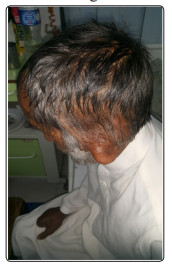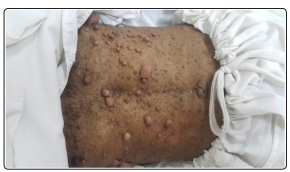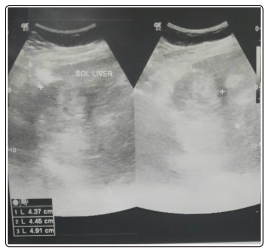Author(s): Madeeha Subhan Waleed
Neurofibromatosis (NF) is an inherited disorder of nervous tissue and skin and have two forms type 1 and type 2.We present to you a 62 year old male with neurofibromatosis having developed hemangioma in the left lobe of liver. NF1 patients should be managed in time to decrease morbidity and mortality of the patient.
Neurofibromatosis(NF) is an inherited disorder of nervous tissue and skin and have two forms type 1 and type 2. [1-3]. NF1 accounts for 90 percent of all neurofibromatosis. This disease has a prevalence of 1/ 3,000 births [1-8]. Hepatic hemangiomas are benign malignancies that usually don’t grow but if they grow they require intervention[9].
A 62 year old male presented to the hospital with abdominal pain and watery diarrhea since a week .he had 5 episodes in a day and the diarrhea was watery in consistency. He also complained of anorexia since the past month but no weight loss was documented. On examination he had dyspnea on exertion and his abdomen had guarding and was tender. His bowel sounds were positive. He smoked cigarette as well as hukka with a history of one pack per day for 25 years.No other comorbidities were present. He had pallor and neurofibromas all over his body with the largest being behind his left ear as shown in Figure: 1 and 2.


His rest of the systemic examination was normal. His ultrasound showed a hemangioma in the left lobe of the liver measuring 4.4cmX4.3X4.9cm as shown in Figure: 3

The patient was managed conservatively and recovered fine. Regular followup of the patient was done every 6 months to look for growth of hemangioma or any other complication related to NF1.
Neurofibromatosis type 1 also known as Von Recklinghausen’s disease is a rare disease that is inherited tumors of nerves and skin. Friedrich Daniel von Recklinghausen wrote a paper inthe year 1882 on NF [10]. Robert William Smith explained the symptoms on NF in the year 1849 [11]. Von Recklinghausen’s neurofibromatosis prevalence is between 1/3000 and 1/5000 live births [12]. Hemangioma is the most common type of benign tumor that occurs in the liver [13]. The prevalence of hemangioma is about 3%-20%.It is common in middle-aged women [14].The patient has neurofibromatosis 1 having haemangioma in the left lobe of the liver.
NF1 is a disorder involving almost the systems of the body and should be managed accordingly by a physician and a genctic specialist.geneticist . NF1 patients should be managed in time to decrease morbidty and mortality of the patient.More studies should be done in finding more treatment options for NF1.If diagnosed early the patients can be monitored to reduce the disabling compliactions that can happen.
There is no conflict of interest.
Informed Consent was taken from the patient.
